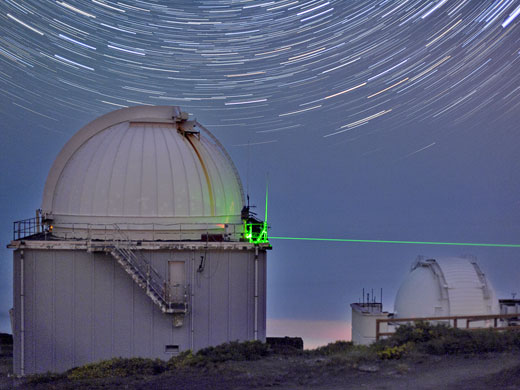An international team led by the Austrian physicist Anton Zeilinger has successfully transmitted quantum states between the two Canary Islands of La Palma and Tenerife, over a distance of 143 km. The previous record, set by researchers in China just a few months ago, was 97 km.
Breaking the distance record wasn’t the scientists’ primary goal though. This experiment provides the basis for a worldwide information network, in which quantum mechanical effects enable the exchange of messages with greater security, and allow certain calculations to be performed more efficiently than with conventional technologies. In such a future ‘quantum internet’, quantum teleportation will be a key protocol for the transmission of information between quantum computers.
In a quantum teleportation experiment, quantum states — but not matter — are exchanged between two parties over distances that can be, in principle, arbitrarily long. The process works even if the location of the recipient is not known. Such an exchange can be used either for the transmission of messages, or as an operation in future quantum computers. In these applications the photons that encode the quantum states have to be transported reliably over long distances without compromising the fragile quantum state. The experiment of the Austrian physicists, in which they have now set up a quantum connection suitable for quantum teleportation over distances of more than 100 km, opens up new horizons.
Xiao-song Ma, one of the scientists involved in the experiment, says: "The realization of quantum teleportation over a distance of 143 km has been a huge technological challenge." The photons had to be sent directly through the turbulent atmosphere between the two islands. The use of optical fibres is not suitable for teleportation experiments over such great distances, as signal loss would be too severe. To reach their goal, the scientists had to implement a series of technical innovations. Support came from a theory group at the Max Planck Institute for Quantum Optics in Garching (Germany) and an experimental group at the University of Waterloo (Canada). Ma also said "An important step for our successful teleportation was a method known as ‘active feed-forward', which we have used for the first time in a long-distance experiment. It helped us to double the transfer rate". In an active feed-forward protocol, conventional data is sent alongside the quantum information, enabling the recipient to decipher the transferred signal with a higher efficiency.
"Our experiment shows how mature ‘quantum technologies' are today, and how useful they can be for practical applications," says Anton Zeilinger. "The next step is satellite-based quantum teleportation, which should enable quantum communication on a global scale. We have now taken a major step in this direction and will use our know-how in an international cooperation, which involves our colleagues at the Chinese Academy of Sciences. The goal is to launch a ‘quantum satellite mission’."
Rupert Ursin, who has been working with Zeilinger on long-distance experiments since 2002, adds: "Our latest results are very encouraging with a view to future experiments in which we either exchange signals between Earth and satellites or send messages from one satellite to another." Satellites in ‘low-Earth orbit’ fly between 200 and 1200 km above the surface of the Earth. (The International Space Station, for example, orbits at an altitude of about 400 km.) "On the way through the atmosphere from La Palma to Tenerife, our signals have been attenuated by a factor of roughly one thousand. Nevertheless, we managed to perform a quantum teleportation experiment. In satellite-based experiments, the distances to be travelled are longer, but the signal will have to pass through less atmosphere. We have now created a sound basis for such experiments."
This work was made possible by grants from the European Space Agency, the Austrian Science Foundation (FWF), and the FFG. We also acknowledge support by the European Commission.
Online Publication:
Quantum teleportation over 143 kilometres using active feed-forward.
Xiao-Song Ma, Thomas Herbst, Thomas Scheidl, Daqing Wang, Sebastian Kropatschek, William Naylor, Bernhard Wittmann, Alexandra Mech, Johannes Kofler, Elena Anisimova, Vadim Makarov, Thomas Jennewein, Rupert Ursin & Anton Zeilinger.
Nature DOI:10.1038/nature11472 (2012).
Scientific contact:
Dr Rupert Ursin
Institute for Quantum Optics and Quantum Information (IQOQI)
Austrian Academy of Sciences, Boltzmanngasse 3, A-1090 Vienna, Austria
M: +43 664 8847 6595
rupert.ursin@univie.ac.at
VCQ Press:
Mag. Barbara Suchanek
Boltzmanngasse 5, 1090 Wien
T: +43 1 4277 72545
F: +43 1 4277 9512
vcq[at]quantum.at

